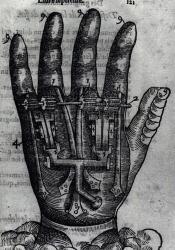The Prosthetic Hand
As Jane returns to Thornfield, she learns from an inn’s host about the tragedy that has befallen upon Mr. Rochester. Not only has she learned that Thornfield has been destroyed in a fire caused by Rochester’s wife, but also that Mr. Rochester suffered injury from the crash of the mansion around him, causing him to be blinded and for one of his hands to be crushed. The host recounts that “‘one hand [was] so crushed that Mr. Carter, the surgeon, had to amputate it directly,’” thus rendering Rochester a “cripple” (Bronte 382).
After his hand is amputated and his home destroyed, Rochester secludes himself from nearly everybody. When Jane first sees Rochester, he appears to be hiding his missing limb inside his jacket (Bronte 384). And then when Jane finally reconnects with Rochester, he appears ashamed of his missing limb, telling her, “‘I thought you would be revolted, Jane, when you saw my arm and cicatrised visage,’” (Bronte 388). Although it is unclear when the novel Jane Eyre takes place, the option to have an artificial limb or prosthetic limb was available mostly to the wealthy in the 19th century (Armfield para 6). In fact, as far back as the 16th century there were ideas about the prosthetic limb, the hand in particular, with Ambroise Pare, a French military surgeon, creating the first design of a prosthetic hand (Zuo and Olsen para 5). With advancements being made in the Victorian era, the prosthetic limb became a more viable option.
Mr. Rochester was considered wealthy and seemed to have the concept of a prosthetic hand at his disposal, and yet there is no mention of him getting one. Instead, he simply has no left hand and Jane helps assist him where needed. He explains the situation to her in the words, “‘...to bear my infirmities, Jane: to overlook my deficiencies,’” (Bronte 396). Whatever his reason for not getting a fake limb, I think it says something about his character. Knowing these options might have been available for Rochester, we can perhaps assume it was a thing of pride. He might not have wanted to feel worse about his condition with the addition of a limb that probably didn’t look as realistic as it might have now. Understanding Rochester’s character, this might have been his reasoning. Seeing how, after the accident, he isolates himself from everyone, he might have felt a shame that only would have been made worse by getting a prosthetic hand to replace his lost one; especially as the whole accident was caused by his wife, someone who continually brought shame to Rochester.
Works Cited
Armfield, Julia. “Without a Leg to Stand On – Victorian Prosthetics.” Untold lives blog, https://blogs.bl.uk/untoldlives/2013/10/without-a-leg-to-stand-on-victor.... Accessed 27 January 2022.
Bronte, Charlotte. Jane Eyre, edited by Deborah Lutz, 4th ed., New York, W. W. Norton & Company, 2016.
Zuo, Kevin J, and Jaret L Olson. “The evolution of functional hand replacement: From iron prostheses to hand transplantation.” Plastic surgery (Oakville, Ont.) vol. 22,1 (2014): 44-51.
Image Citation
Pare, Ambroise. Hand with mechanical apparatus. National Library of Medicine, Jean Le Royer, 1564, https://collections.nlm.nih.gov/catalog/nlm:nlmuid-101448278-img?sort=Ti....

